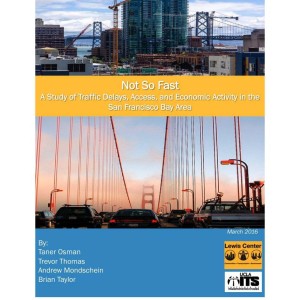
Authors: Taner Osman, Trevor Thomas, Andrew Mondschein, Brian Taylor
Date: March 1, 2016
Project: [wpv-post-link id=”$project”]
While often overshadowed by traffic-choked Los Angeles to the south, the San Francisco Bay Area regularly experiences some of the most severe traffic congestion in the U.S. This past year both Inrix and the Texas Transportation Institute (TTI) ranked the Bay Area third only to Washington D.C. and Los Angeles in the time drivers spend stuck in traffic. Such rankings are widely viewed as badges of shame, tagging places as unpleasant, economically inefficient, even dystopian. Indeed, the economic costs of chronic traffic congestion are widely accepted; the TTI estimated that traffic congestion cost the Bay Area economy – by some measures the nation’s most vibrant regional economy – a staggering $3.1 billion in 2014 (Lomax et al., 2015).
Such estimates are widely accepted by public officials and the media and are frequently used to justify major new transportation infrastructure investments. They are based on the premise that moving slowly than free-flow speeds wastes time and fuel, and that these time and fuel costs multiplied over millions of travelers in large urban areas add up to billions of dollars in congestion costs. For example, a ten mile, ten minute suburb-to-suburb freeway commute to work at 60 miles per hour might occasion no congestion costs, while a two mile, ten minute drive to work on congested central city streets – a commute of the same time but shorter distance – would be estimated to cost a commuter more than 13 minutes (round trip) in congested time and fuel costs each day.
But while few among us like driving in heavy traffic, do such measures really capture how congestion and the conditions that give rise to it affect regional economies? This study explores this question for San Francisco Bay Area by examining how traffic congestion is (i) related to a broader and more conceptually powerful concept of access and (ii) how it affects key industries, which are critical to the performance of the region’s economy. It is a companion to a similar analysis of Metropolitan Los Angeles we completed in 2015 (Mondschein et al 2015), and includes comparative findings with the results of that study.
Link to Publication